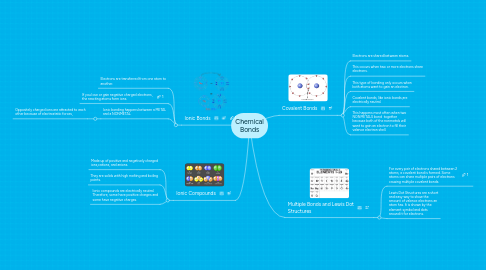Chemical Bonds
by Isabella Levere

1. Ionic Bonds
1.1. Electrons are transferred from one atom to another.
1.2. If you lose or gain negative charged electrons, the reacting atoms form ions.
1.3. Ionic bonding happens between a METAL and a NONMETAL.
1.3.1. Oppositely charged ions are attracted to each other because of electrostatic forces,
2. Multiple Bonds and Lewis Dot Structures
2.1. For every pair of electrons shared between 2 atoms, a covalent bond is formed. Some atoms can share multiple pairs of electrons causing multiple covalent bonds.
2.2. Lewis Dot Structures are a short and easy way to show the amount of valence electrons an atom has. It is shown by the element symbol and dots around it for electrons.
3. Covalent Bonds
3.1. Electrons are shared between atoms.
3.2. This occurs when two or more electrons share electrons.
3.3. This type of bonding only occurs when both atoms want to gain an electron.
3.4. Covalent bonds, like ionic bonds,are electrically neutral.
3.5. This happens most often when two NONMETALS bond together because both of the nonmetals will want to gain an electron to fill their valence electron shell.
4. Ionic Compounds
4.1. Made up of positive and negatively charged ions,cations, and anions.
4.2. They are solids with high melting and boiling points.
4.3. Ionic compounds are electrically neutral. Therefore, some have positive charges and some have negative charges.


